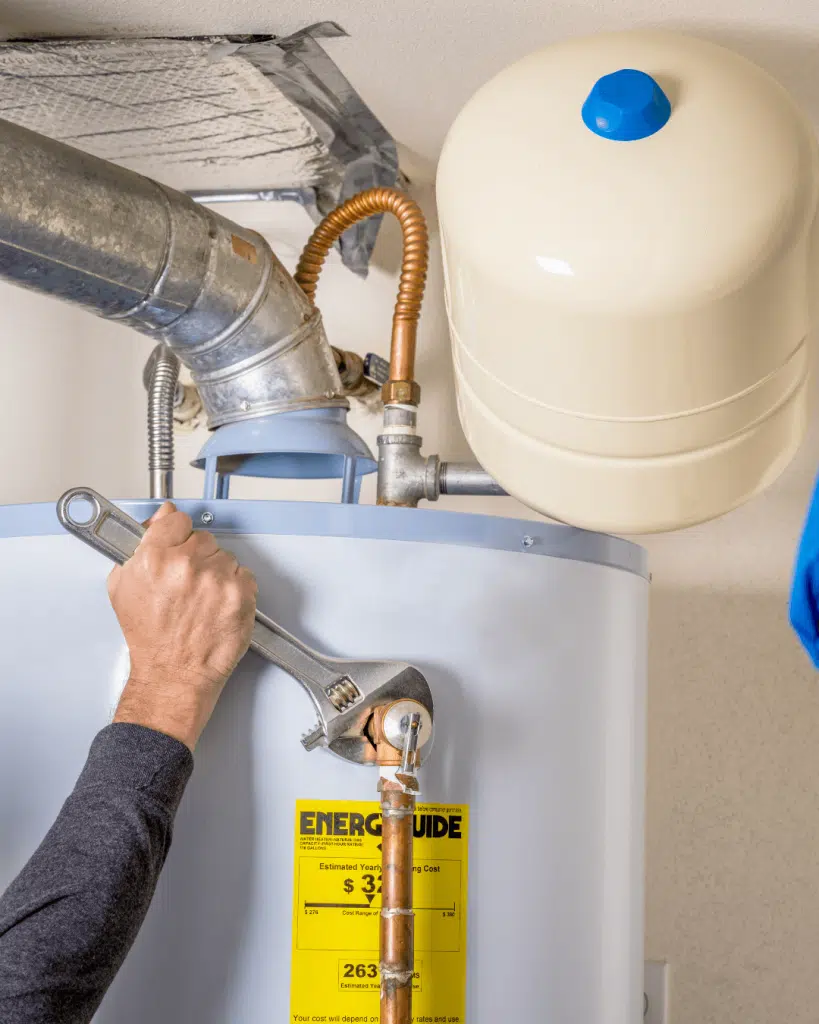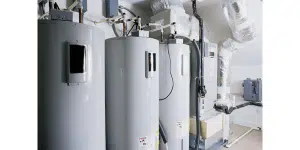What is a Water Heater Expansion Tank?

Inside the expansion tank, there’s a clever mechanism separating water from air, usually a diaphragm or bladder. As the water expands, it enters the tank and compresses this internal air or bladder, effectively regulating the system’s pressure. This process ensures that the pressure remains within safe limits, even as the water temperature fluctuates.
The need for expansion tanks arises from the evolution of modern plumbing systems. With the widespread use of check valves in water mains to prevent backflow – the undesirable reversal of water flow – excess pressure from heated water has nowhere to escape. While these check valves protect our water supply from contamination, they inadvertently create a pressure buildup within the plumbing system. Here, the expansion tank steps in, providing a release valve for the expanding water and maintaining the system’s equilibrium.
Installation of expansion tanks is often mandated by plumbing codes, especially in systems equipped with backflow prevention devices, pressure-reducing valves, or check valves. These regulations are proactive measures aimed at safeguarding plumbing infrastructure and prolonging the lifespan of water heaters. In essence, the humble water heater expansion tank plays a crucial role in ensuring the smooth operation and longevity of your plumbing system, quietly protecting your home from potential water damage.
Basics of Water Heater Expansion Tanks
When it comes to maintaining your water heater system, understanding the basics of expansion tanks is essential. These unassuming tanks play a crucial role in protecting your plumbing system from damage caused by thermal expansion.
Understanding the Mechanism of a Water Heater Expansion Tank
Imagine your water heater expansion tank as a pressure relief valve for your plumbing system. As the water heats up within the water heater, it expands, potentially causing excessive pressure within the system. This pressure can lead to damage to valves, joints, and even the water heater itself.
Here’s where the expansion tank steps in: it provides a designated space for the expanding water to flow into, effectively relieving pressure from the system. Inside the tank, a diaphragm or bladder separates the water from the air. As the water expands, it compresses this internal air or bladder, maintaining pressure equilibrium within the system.
Is an Expansion Tank Necessary for Your Water Heater?
The necessity of an expansion tank depends on various factors, including the type and size of your water heating system, as well as local plumbing regulations. In general, most residential water heating systems with closed plumbing systems require an expansion tank to mitigate the risks associated with thermal expansion.
If your water heating system incorporates devices like backflow prevention devices, pressure-reducing valves, or check valves, the likelihood of needing an expansion tank increases. These devices can inadvertently elevate water pressure, intensifying the effects of thermal expansion.
However, exceptions exist. Open plumbing systems, such as those found in some solar heating or gravity-fed systems, may not necessitate an expansion tank.
Consulting with a licensed plumber is always recommended to determine whether your specific water heating system requires an expansion tank. By adhering to local plumbing codes and regulations, you can ensure the optimal performance and longevity of your water heater system.
Considering Adding an Expansion Tank to Your Water Heater?

Installing a Water Heater Expansion Tank
Installation is typically straightforward, with expansion tanks commonly placed above the water heater on the cold water line before it enters the heater. However, they can be installed anywhere along this line. Prices for expansion tanks vary, starting around $40 and going up to $200, depending on the tank size. For most residential setups with 40- or 50-gallon water heaters, a simple 2-gallon tank suffices. Installation involves connecting the tank to the cold water line using a standard 3/4-inch threaded connection. If a T-fitting isn’t already in place above the water heater, one must be installed.
Knowing When to Replace Your Water Heater Expansion Tank
Typically, expansion tanks require replacement every five to 10 years. Extending the tank’s lifespan to a decade is possible by matching its pressure to the incoming water pressure, preventing bladder damage and valve leaks. Signs of trouble include dripping water, indicating possible mineral deposits or debris blockages in valves, and changes in pressure that can harm the bladder and cause heat loss. Regular checks with a water pressure gauge and adjustment of air pressure using a tire gauge can help maintain the tank’s efficiency.
Contact Trusted Plumbing and Heating for Installing a Water Heater Expansion Tank
If you’re considering adding or replacing a water heater expansion tank, our team at Trusted Plumbing and Heating is here to help. Whether it’s installation, maintenance, or replacement, our expert plumbers ensure top-notch service to keep your water heater system running smoothly. Contact us today to get a quote or call us at (425) 333-2559 to schedule an appointment and experience peace of mind with your plumbing system.
